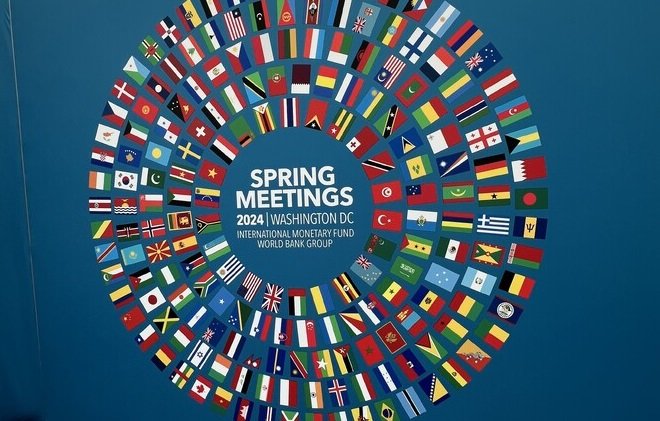
Last week at the The World Bank and International Monetary Fund Spring Meetings in Washington, USA (17-19 April 2024), amidst the doom and gloom of the state of the global economy, the great reversal in IDA countries, several countries experiencing declines in overall overseas development aid (ODA), and the high number of countries in debt distress on the African continent, it was refreshing to hear some positive news!
The World Bank Group President Ajay Banga announced two new initiatives that will transform the lives of over a billion people on the African continent. The first announcement, made in partnership with Dr Akinwumi Adesina, President of the African Development Bank Group, will see nearly half the 600 million Africans currently without energy access connected by 2030. “Electricity is the basis by which people can get access to health, people can get access to education, people can get access to the ability to innovate and manufacture and build productivity”, said Banga.
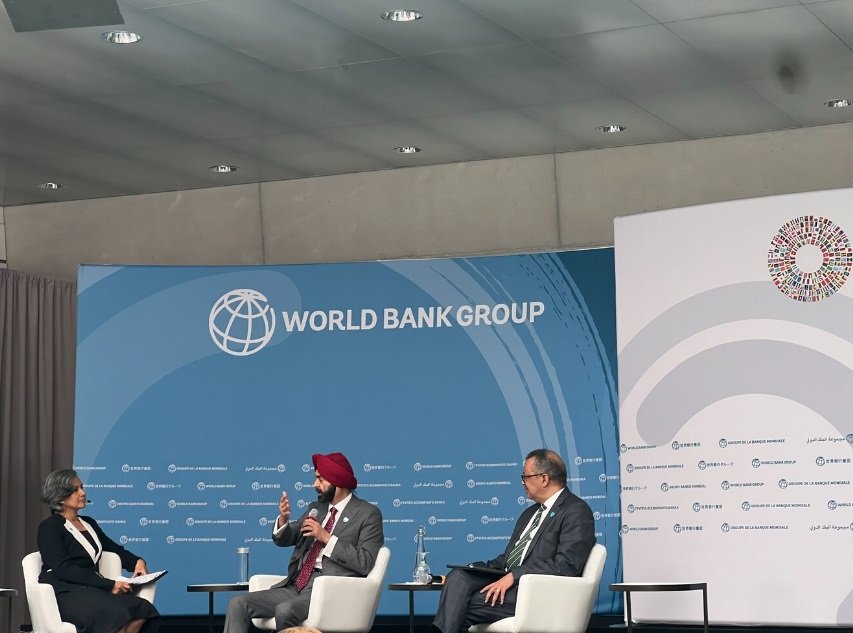
The second announcement, which really piqued my interest and was made in partnership with the World Health Organization (WHO) Director General, Dr. Tedros Adhanom Ghebreyesus, was directly focused on health. Its ambition is to support low and middle-income countries in delivering quality, affordable health services to 1.5 billion people by 2030 in a stride to achieve Universal Health Coverage (UHC). “Reach them means really reach them. I don't mean reach as in you put up a center and everybody in the area is counted. This is actually touching the person with a medical appointment, either physical or through telehealth…”, said Banga.
But can the bank really reach 1.5 billion more individuals with a health service by 2030 i.e. over the next six years?
I have good news for Ajay Banga. This target is not a pipe dream. It is totally doable and is within reach. One way of getting to this goal is to target the 1.6 billion people affected by neglected tropical diseases (NTDs) with a health intervention.
One way of getting to this goal is to target the 1.6 billion people affected by neglected tropical diseases (NTDs) with a health intervention.
NTDs are a group of preventable and treatable diseases which cause immeasurable suffering. They include diseases like bilharzia, sleeping sickness, river blindness, leprosy, and lymphatic filariasis. These are diseases which commonly affect some of the most vulnerable people in the world - often living in remote communities - that drive cycles of poverty.
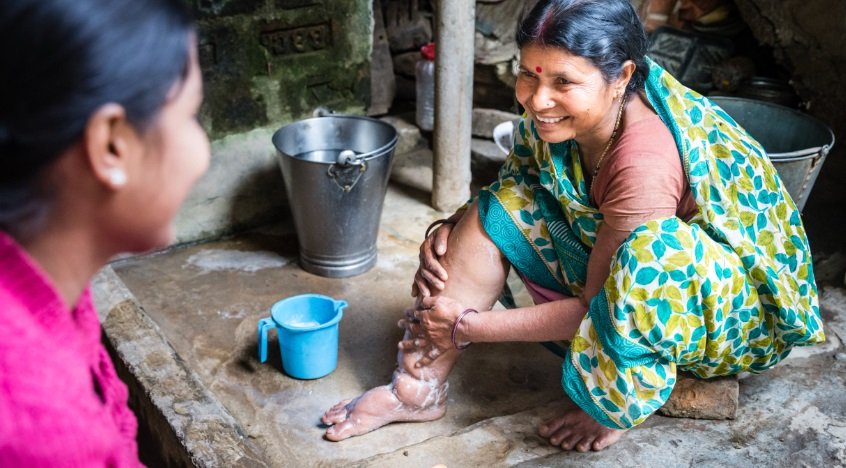
These diseases can feel distant from the World Bank setting in Washington D.C., where world leaders gathered for the Spring Meetings, yet, taking pride of place in the World Bank Atrium is a sculpture of river blindness also known as onchocerciasis. The sculpture stands tall, depicting a young child guiding an adult with a stick, a scene common in many African villages where adults have been blinded by river blindness and children have to drop out of school to look after their relatives. I had great conversations with leaders around this sculpture, many of whom walk past it every day but have become numb to it and forgotten the global commitment towards the people affected by this disease. On the sculpture is this inscription - “Defeating River Blindness in Africa: Successful Human Development Through Global Partnership.
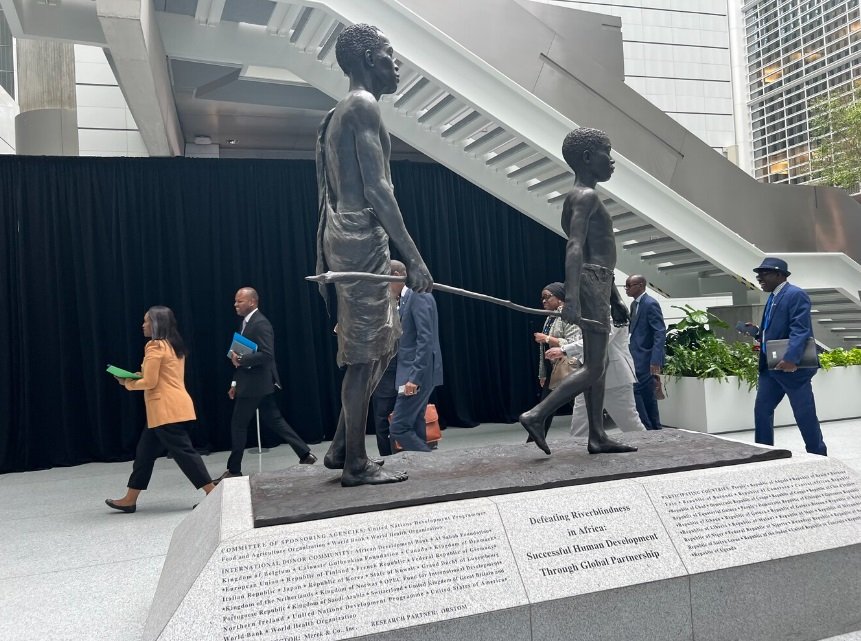
How is the world currently performing in reaching these 1.6 billion people with an intervention against an NTD?
According to the most recent data from WHO, whilst a record number of countries are achieving the goal of eliminating at least one of these diseases as a public health problem, with an incredible 50, out of a target of 100 countries, having eliminated at least one NTD - we are still a long way off the Sustainable Development Goal (SDG) indicator of a 90% reduction in the number of people requiring an intervention against an NTD by 2030.
With just six years to 2030, we have only managed to reduce by 26%, the number of people requiring an intervention against an NTD.
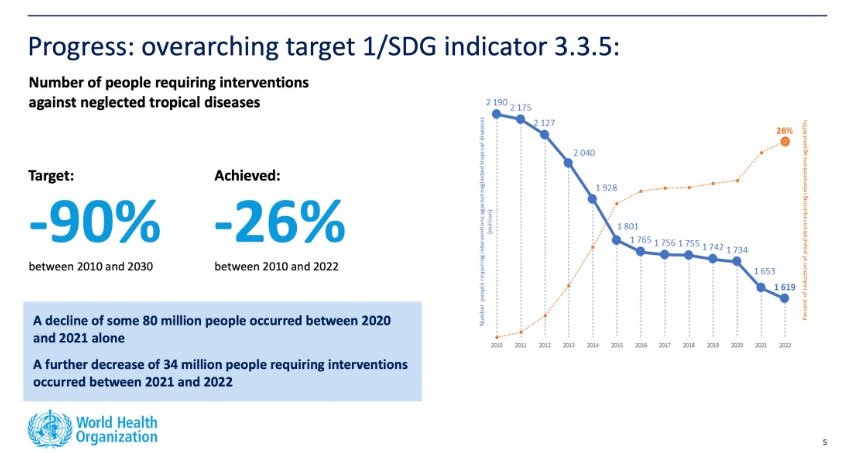
Image Credit: World Health Organization
Indeed, when it comes to the number of people receiving an intervention against an NTD compared to those needing it, i.e. service coverage, 848 million are reported by WHO to have received an intervention against an NTD in 2022. That’s just over half of all the 1.6 billion people requiring services against NTDs.
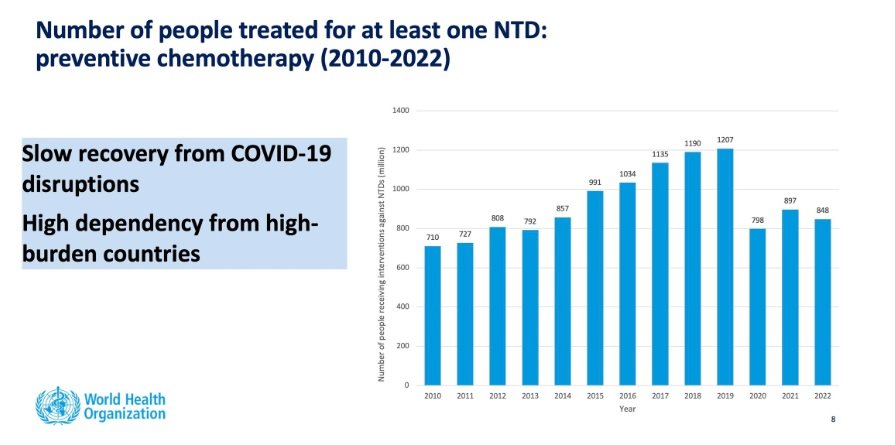
Image Credit: World Health Organization
Progress was steadily mounting before the pandemic struck. Between 2016 and 2019, prior to COVID-19, NTD programmes were reaching over a billion people with an NTD intervention per annum. That figure dropped dramatically in 2020 to 798 million and was still below the one billion mark in 2022. This means over 800 million people currently requiring an intervention against an NTD are not being reached. These represent the poorest people on our planet who risk being pushed deeper into poverty due to diseases we know how to treat and prevent.
Over 800 million people currently requiring an intervention against an NTD are not being reached.
This drop in coverage is against the backdrop of an extraordinary public health partnership in global health, where 13 global pharmaceutical companies have committed to donate billions of medicines to treat and prevent NTDs to the countries that request them. The medicines are donated for free, but we lack the resources to get them to the people that need them the most. Countries are simply not able to mobilise enough money - either from international partners or from domestic revenues - in order to treat their citizens and prevent immeasurable suffering. This is not just a gross injustice, but a case of missed opportunity.
Take schistosomiasis for example, known as bilharzia or snail fever. This disease aptly demonstrates what Banga talked about in terms of expanding the aperture from maternal and child health to adolescent and adult health. It affects all age groups, from infants to adults, particularly women and girls.
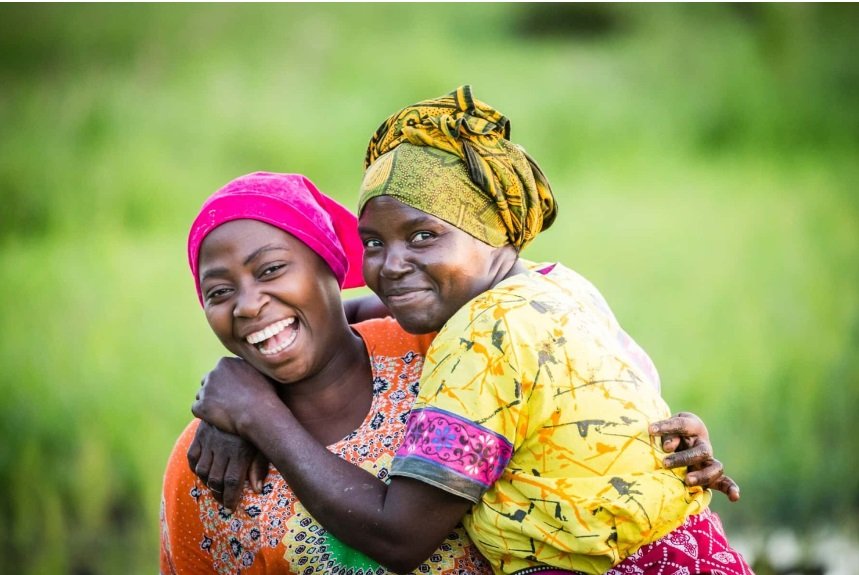
Photo Credit GSK Marcus Perkins
Schistosomiasis is an acute and chronic parasitic disease caused by worms that develop in freshwater snails found in the freshwater bodies that rural communities depend on. Poor sanitation and inadequate safe water provision means that children playing in water, women doing domestic chores - such as washing clothes or dishes, fishermen and men engaged in car wash businesses in infested water are especially vulnerable to infection.
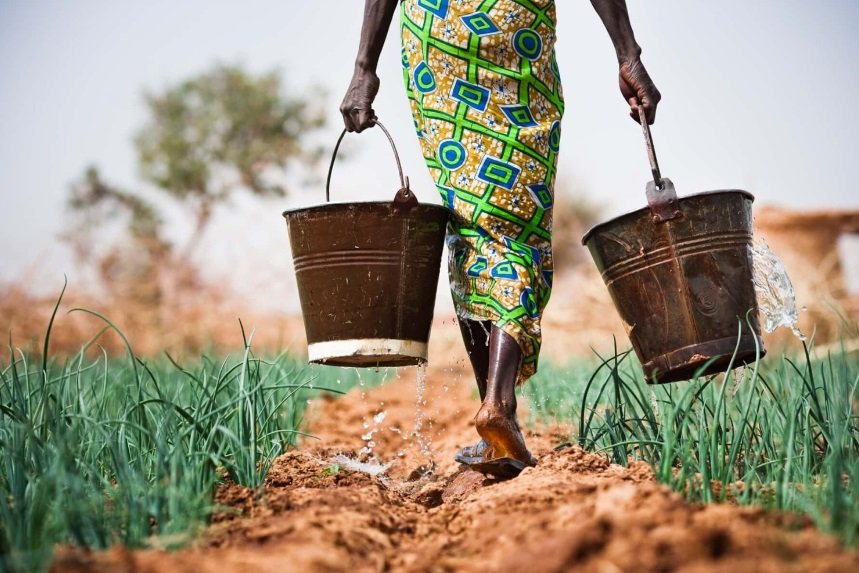
Photo Credit GSK Marcus Perkins
It is estimated that 200 million people require preventive treatment for schistosomiasis worldwide. In children the disease contributes to malnutrition, stunted growth, school absenteeism and impaired cognitive development. If left untreated in women, the disease can progress to female genital schistosomiasis (FGS) which can irreversibly damage reproductive organs and lead to infertility, ectopic pregnancy, or maternal death. FGS can also triple the risk of HIV infection further impacting global efforts to reduce new HIV infections in adolescent girls.
The mainstay of schistosomiasis control is routine mass administration of medicine. Indeed, the WHO strategy focuses on reducing disease through periodic, targeted treatment with praziquantel through the large-scale treatment (preventive chemotherapy) of affected populations.
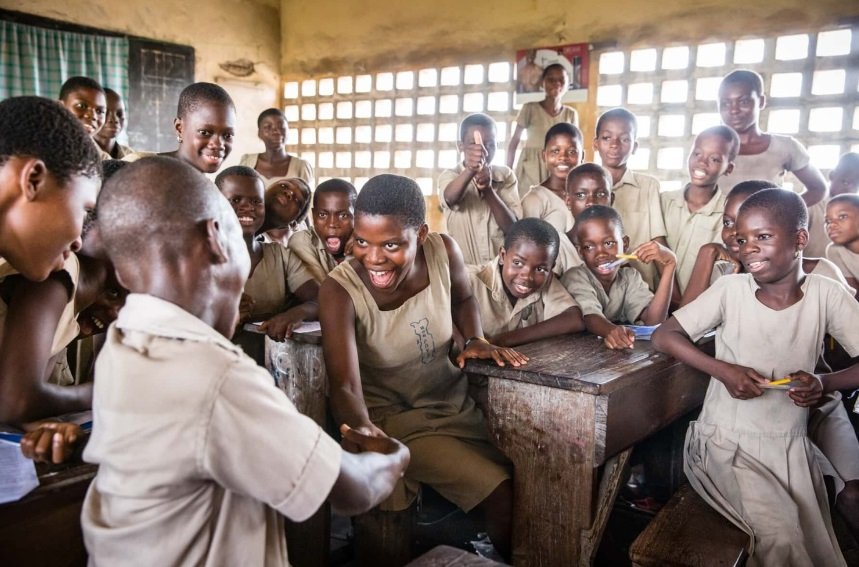
Photo Credit GSK Marcus Perkins
Through the London Declaration in 2012, reaffirmed in the Kigali Declaration in 2022, Merck committed to donate up to 250 million praziquantel tablets to treat schistosomiasis yearly. This is enough to reach 100 million school aged children per year. Furthermore, Merck, alongside the Paediatric Consortium, has invested in a new paediatric formulation which recently received a positive scientific opinion from the European Medicines Agency (EMA). This formulation will make it easier to treat children under the age of five, so that they are protected from the lifelong consequences of this insidious disease.
However, since this commitment to donate 250 million tablets to countries, on an annual basis was made by Merck, there has not been a single year when the full value of the donation has been utilised. In fact, as things stand, the current request for 2024, based on funding available from countries and donors for distribution of medicines to populations in need, is less than half of the committed medicines. This means that millions of people who have been infected by schistosomiasis this year will not be reached. In spite of the medicine to treat them being freely available.
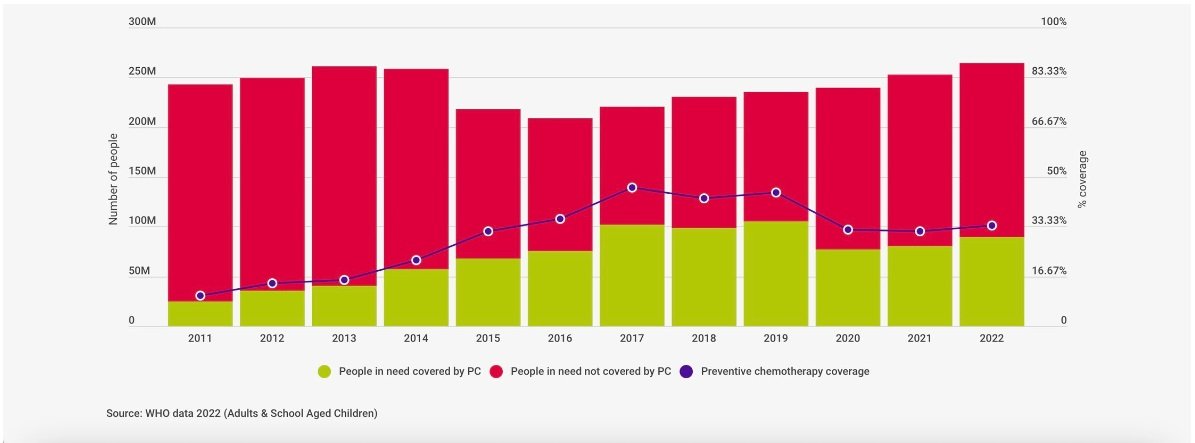
I believe addressing this issue is a low hanging fruit for Banga. As part of the World Bank’s new commitment to expand access to healthcare for 1.5 billion people, Banga could:
- Commit to ensure that at least 100 million people are reached with treatment for schistosomiasis every year to 2030, at a very minimum. This will fully utilise the value of the donation from industry partners.
- Support access by countries to the new praziquantel paediatric formulation targeting children under five years of age. This will reach and improve the lives of millions of children.
- Work with WHO to estimate the full need for schistosomiasis beyond the value of the donated medicines and aim to reach everyone in need with a treatment.
- Prioritise ‘Disease Elimination’ as a Flagship Initiative for IDA21 in which a dedicated funding stream is established under IDA21’s Health Track. With only 15% of the SDGs on track and the need to demonstrate impact at scale, it will be important to support countries that are on the pathway to eliminating NTDs by 2030, helping 50 more countries achieve elimination goals. This will be a smart investment for IDA21. It will deliver tangible impact and at scale.
This is a win-win-win for achieving the World Bank’s priorities. In addition to achieving health impacts and pushing towards Health for All. Funding disease elimination would help the World Bank to achieve its mandate to alleviate poverty, boost economic growth, and improve living conditions for millions of people on a liveable planet. NTDs limit the potential of individuals to earn a living and children from going to and staying in school, so eliminating them has wide-reaching education and poverty-reduction impacts.
I am very optimistic about this vision to reach 1.5 billion people by 2030. Together, we can do it! The global partnership working to end neglected tropical diseases would love nothing more than to join Banga in this bold ambition.
Then in 2030, we can truly stand in front of the World Bank sculpture on river blindness and celebrate the great progress we have achieved in ending NTDs.
Read the World Group’s press release - World Bank Group Aims to Expand Health Services to 1.5 Billion People